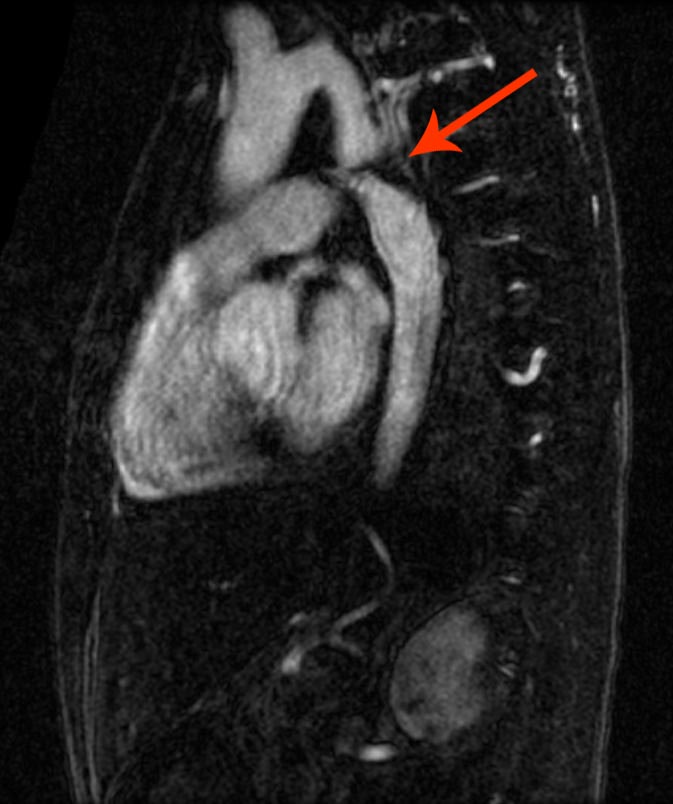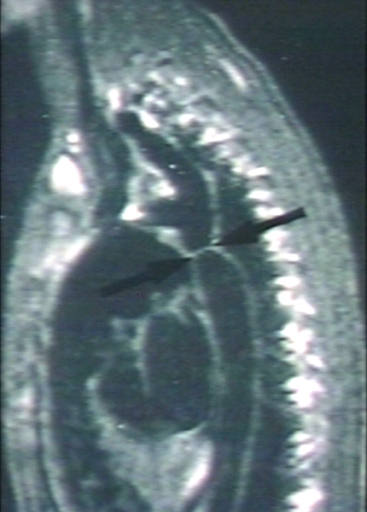Aortic coarctation MRI
Please help WikiDoc by adding more content here. It's easy! Click here to learn about editing.
|
Aortic coarctation Microchapters |
|
Diagnosis |
|---|
|
Treatment |
|
Case Studies |
|
Aortic coarctation MRI On the Web |
|
American Roentgen Ray Society Images of Aortic coarctation MRI |
|
Risk calculators and risk factors for Aortic coarctation MRI |
Editor-In-Chief: C. Michael Gibson, M.S., M.D. [1]; Associate Editor-in-Chief: Cafer Zorkun, M.D., Ph.D. [2]
Overview
Magnetic resonance imaging (MRI) can define the location and severity of a coarctation. MRI can also detect associated cardiac abnormalities and is used for serial follow-up after surgical repair or balloon angioplasty. MRI is recommended to look for aneurysm formation following repair of a coarctation. MR angiography has almost completely replaced invasive catheter based techniques for evaluating re-coarctation. In adults with untreated coarctation blood often reaches the lower body through collaterals, e.g. internal thoracic arteries thorugh the subclavian arteries. Those can be seen on MRI or angiography.
MRI
Shown below are the MRI images for coarctation of aorta.
 |

|
Courtesy of RadsWiki and copylefted
 |

|

A. 'Black-blood' oblique sagittal view showing discrete, tight coarctation at the aortic isthmus (arrow).
B. 3D, contrast-enhanced CT angiogram showing mildly narrowed bare metal stent (arrow) that partially overlies the left subclavian artery origin. The arrowhead shows a subtle pseudo-aneurysm at the distal end of the stent.
C. 3D, contrast-enhanced MR angiogram showing aortic arch hypoplasia and coarctation with a 'jump' by-pass graft posteriorly (arrow).
D. 3D, contrast-enhanced MR angiogram showing large pseudo-aneurysm (arrowhead) after previous patch angioplasty repair. The true lumen is shown posteriorly (arrow).
2008 ACC/AHA Guidelines for the Management of Adults With Congenital Heart Disease (DO NOT EDIT)[1]
Recommendations for Clinical Evaluation and Follow-Up (DO NOT EDIT)[1]
| Class I |
| "1. Every patient with coarctation (repaired or not) should have at least one cardiovascular MRI or CT scan for complete evaluation of the thoracic aorta and intracranial vessels. (Level of Evidence: B)" |
References
- ↑ 1.0 1.1 Warnes CA, Williams RG, Bashore TM, Child JS, Connolly HM, Dearani JA; et al. (2008). "ACC/AHA 2008 guidelines for the management of adults with congenital heart disease: a report of the American College of Cardiology/American Heart Association Task Force on Practice Guidelines (Writing Committee to Develop Guidelines on the Management of Adults With Congenital Heart Disease). Developed in Collaboration With the American Society of Echocardiography, Heart Rhythm Society, International Society for Adult Congenital Heart Disease, Society for Cardiovascular Angiography and Interventions, and Society of Thoracic Surgeons". J Am Coll Cardiol. 52 (23): e1–121. doi:10.1016/j.jacc.2008.10.001. PMID 19038677.